Halmstad entered the international break two points clear at top of the Swedish Superettan having lost just once in their opening ten matches. After that loss to Norrby on match day two, HBK went on a seven-match winning streak, defeating Örebro and Östersunds along the way.
Managed by their former player, Magnus Haglund, Halmstad held on to their undefeated run in the most dramatic of circumstances. Going into injury time of their final match before the break, Vasteras had a 2-0 lead. Two Halmstad goals in the 92nd and 93rd minute clinched an important point away from home for the side hoping to bounce back to the Allsvenskan at the first time of asking.
This analysis will be presented in the form of a scout report focusing on Halmstad’s play without the ball and how they transition to attack. In this tactical analysis, we analyse the key tactics behind Halmstad’s ascent to the top of the league.
Statistical analysis
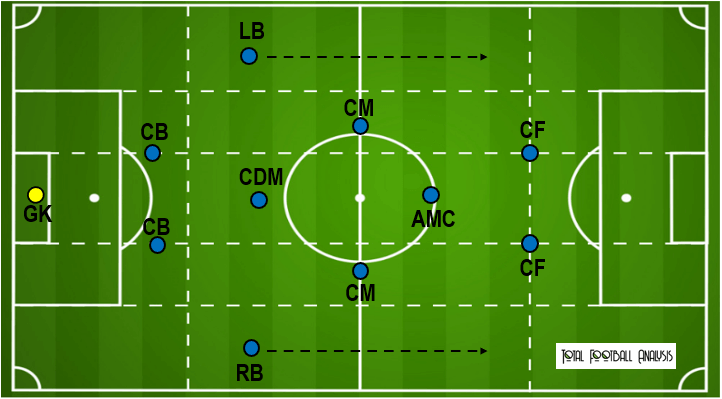
As the above tactical diagram shows, Halmstad’s favoured formation this season is a 4-4-2 diamond. Having gone winless in their first two matches, Haglund adapted his set-ups slightly and has kept with the diamond ever since.
Nine players have contributed to 21 goals in Halmstads ten Superettan matches so far this season. This includes one from the goalkeeper Malkolm Nilsson who claimed the equaliser in their thrilling injury-time comeback draw against Västerås.
12 goals have been shared equally amongst three players. Joseph Baffoe, the former Bundesliga 2 centre-back, has scored three penalties and one goal from a corner. Veteran forward Mikael Boman has scored three of his four goals appearing as a substitute. Youngster Alexander Johansson is another forward contributing from the bench. All four of his goals have been as a substitute and he is currently averaging a goal for every 36 minutes of playing time.
Halmstad average only 47.69% possession this season and this dropped to as low as 36.87% in their 2-1 home victory over Eskilstuna. Only three times this season have they had more of the ball than their opponent. They also average far fewer passes, 385 per match, than their direct opponents 448 passes per match.
Haglund’s preference is to mostly build out from the back using short passes. The statistics back this up with them averaging 50.1 long passes per game (with 59.1% accuracy) compared to their opponents’ 70.3 per game. Long passes account for 13.46% of their passes compared to 16.9% for their opponents. As will be covered in the section on their build-up play, Halmstad’s first inclination is to play short, but they are willing to play long passes to get themselves into their attacking half of the pitch.
High pressing in a 4-4-2 diamond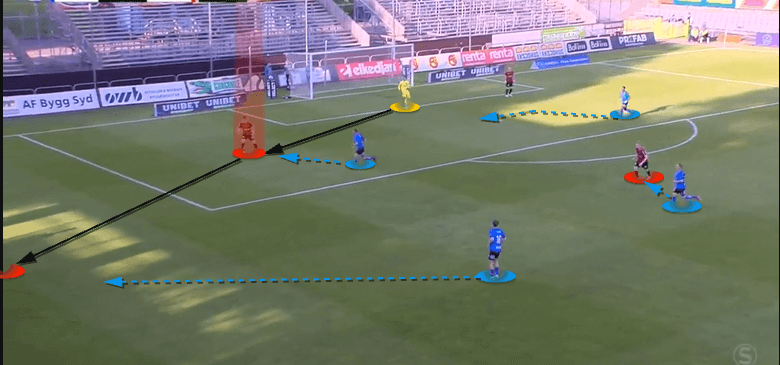
Halmstad press high from goal-kicks, positioning their two forwards at the edge of the box in relation to the opposition’s centre-backs. The AMC man-marks the deepest midfield player and will follow him as high as the edge of the box if he positions himself there. The two wide midfield players are positioned on the edge of the final third in the half-spaces.
When the ball is passed to one of the centre-backs, the nearest forward to the ball presses whilst preventing a pass into midfield. The ball-far forward moves into the box and is positioned to prevent the goalkeeper or opposite centre-back from receiving the ball. These actions force the centre-back to play the ball wide to his open full-back.
The wide midfielder is positioned in the half-space to prevent a pass into the midfield area and to encourage the pass into the full-back. As soon as the wide-midfielder anticipates the pass out wide from the centre-back, he presses and traps the full-back. This usually results in a turnover of possession in Halmstad’s final third or with the full-back clearing the ball and the Halmstad defenders picking it up.
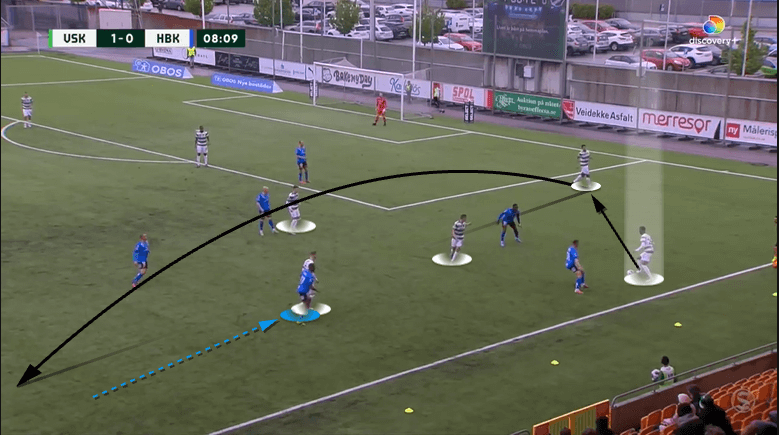
To overcome this press, Västerås overloaded the wide area in their defensive third. When the ball was passed into their wing-back, their two defensive midfielders were within 10-15 yards of the ball. The left centre-back supported beneath him to offer an out ball and prevent him from being trapped.
When the wing-back had the ball at his feet, one of Västerås’ attacking midfielders dropped off into the wide area. The midfielder was tracked by Halmstad’s right-back (highlighted). Halmstad now had their two forwards, AMC, right-midfielder, DMC and right-back all in one area of the pitch.
With six Halmstad players sucked into their defensive third, Västerås dinked the ball over the press and into their centre-forwards feet. The centre-forward, who had dropped deep to receive the ball, brought the Halmstad centre-back with him. The centre-forward was able to spin the centre-back and exploit the space that had been created behind the centre-back and right-back. The centre-forward drove forward with the ball and went on to score Västerås’ second goal.
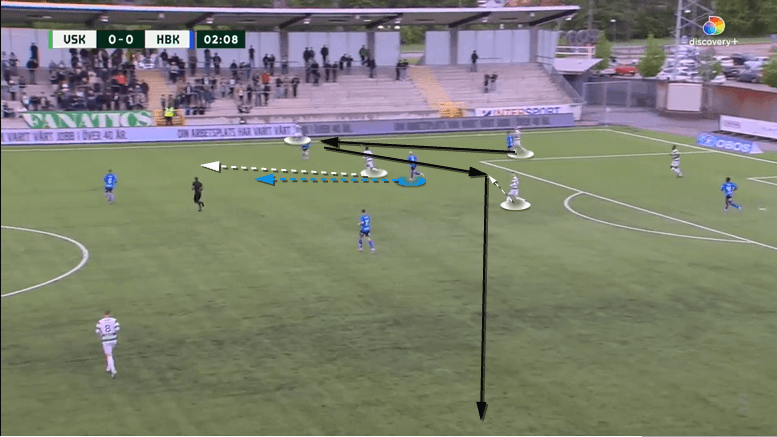
Another way Västerås overcame Halmstad’s press in their build-up phase was through their use of two defensive midfielders. When the opposition builds with two deep midfielders, Halmstad’s attacking midfielder, number ‘7’ Simon Lundevall, presses the nearest one to the ball. Västerås were able to use this to create space for their ball-far midfielder to get on the ball.
The above image shows Västerås’ left wing-back about to receive the ball. The ball near DMC, who is being closely marked by Lundevall, shows to receive ahead of the ball. As Lundevall follows him, the ball-far DMC drops into the space behind him. The ball-far DMC receives the ball and is too far away to be pressed by any of the other central midfielders. This allows him to open up his body and switch the ball to his left-back.
4-4-2 Diamond mid-block
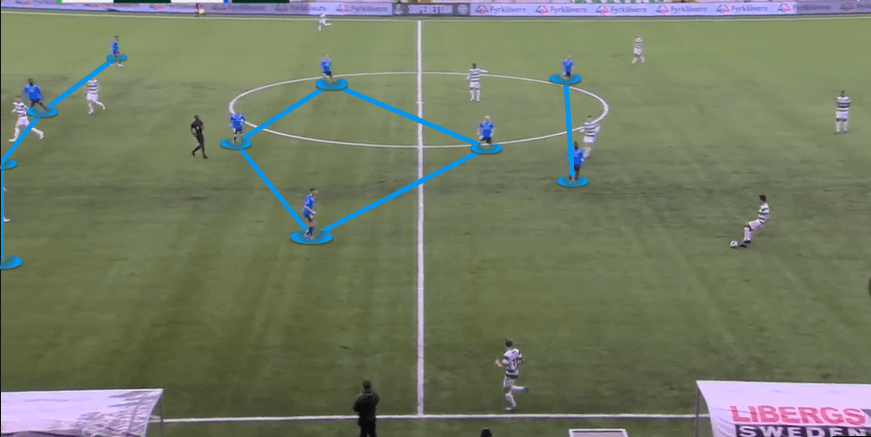
When Halmstad’s high press is broken down or they are not in a good position to put pressure on the ball, they drop into a mid-to-low block. The above image shows the moments after a switch of play from the opposition’s defensive midfielder to his left-back.
Instead of putting immediate pressure on the ball, Halmstad drop diagonally across the pitch. This allows them to regain their shape and set up a mid-block in a clear 4-4-2 diamond formation.
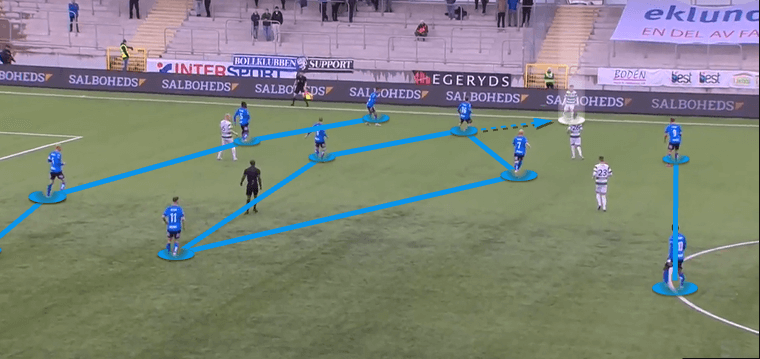
When in the mid-block, Haglund has his side set up to deny space in the centre of the pitch and force teams to play out wide. When the ball goes into the wide areas, it is the wide midfielders who are responsible for pressing. This allows their full-backs to remain as a back four and not get disconnected from their centre-backs.
When pressing in the wide areas, the wide-midfielders’ priority is to prevent the ball from being played forward so he presses whilst cutting off passing lanes into the centre forwards. His defensive midfielder gives cover behind him which also helps shield the centre-backs.
The full-back, if unoccupied, doubles up behind the wide-midfielder. Here we see Marcus Olsson, the former Premier League and EFL left-back, support his wide-midfielder without being dragged too far out. This provides cover should the wide-midfielder be beaten one-on-one. The ball-near forward and AMC also converge on the area. This overloading of the wide area makes it very hard for the opposition to find a forward or central midfielder and usually forces them to play backwards.
However, an issue that arises for the full-backs is when the ball is played backwards and quickly switched to the oppositions wide-forward from a long diagonal. With the entire midfield and both forwards on one side of the pitch, this leaves them exposed. Halmstad conceded from this situation in their previous match when their right-back was stranded in a one-on-one situation after a switch of play.
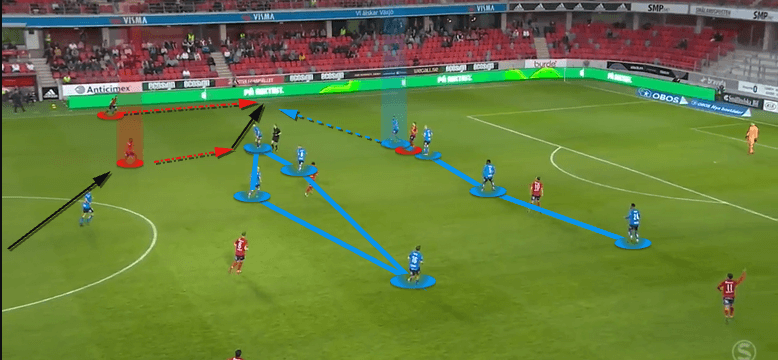
Playing with two players up-front gives Halmstad a serious threat from counterattacks when defending in their mid or low block. When their team wins back possession, the front two immediately occupy the two centre-backs or the two ball-near centre-backs if the opposition are playing with a three.
The above image shows the moments just after Halmstad have won possession from defending in their mid-block. The two forwards are already playing up against the ball-near centre-backs. In these positions, the front two, especially number ‘10’ Sadat Karim, are good at holding the ball up before slipping in a teammate.
Here, the right-midfielder has just received the ball and looks straight away to play the ball into his forward’s feet. Before the ball has been secured by the forward the midfielder has already started his run in behind, showing the trust he has in his forward’s hold-up play.
Karim being able to hold off his opponent and play with his head up gives makes him a great outlet. It allows players to make runs in behind and, as in this situation, bring supporting midfielders into play.
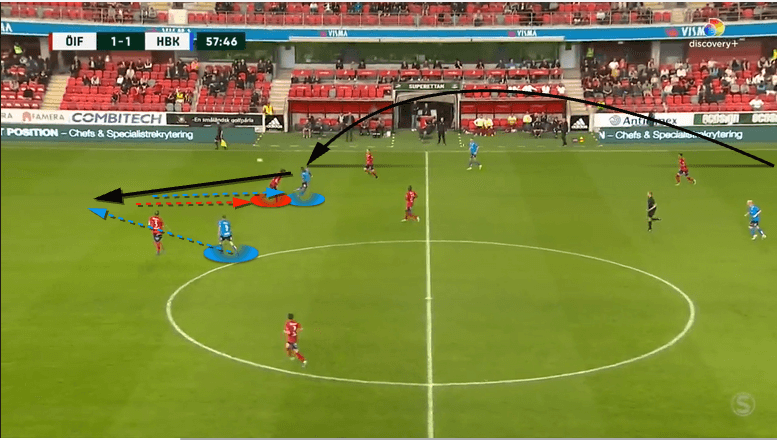
This image shows the ball being played up to Karim after a turnover from deep inside Halmstad’s half. Not only is the Ghanian capable of protecting the ball when it is played into his feet, but he can also win the ball in the air.
This illustrates how effective having two forwards playing up against centre-backs can be. Within seconds of winning the ball back, a long ball and simple movements from the forwards have Halmstad in behind the opposition’s backline.
By playing touch-tight to the centre-back, the defender is enticed to follow Karim towards the ball and compete for the header in the air. This allows for his strike partner to run in behind the competing centre-back and get on the end of his flick-on.
Conclusion
Halmstad’s position in the league and superb current form make them prime candidates to at least claim one of the two automatic promotion spots, if not, the Superettan league title.
They are comfortable both with and without the ball and can press teams with intensity when necessary. They have also shown the fighting spirit required to compete for championships. Haglund must be happy with his side’s progress and will be hoping this international beak does not disrupt his attempts at an immediate return to the Allsvenskan.





Comments